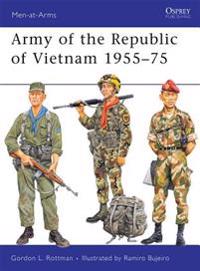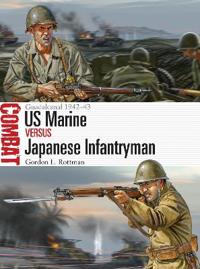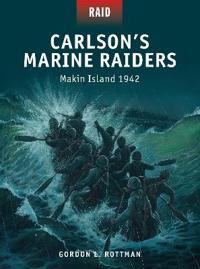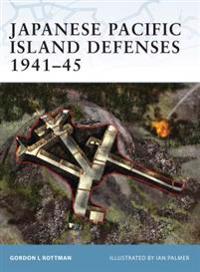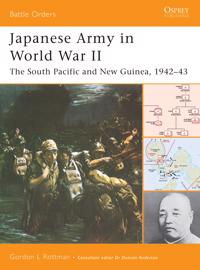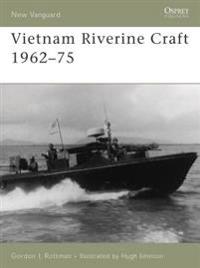Army of the Republic of Vietnam 1955-75 (Pocket)
avGordon L. Rottman, Ramiro Bujeiro, Gordon L. Rottman
ISBN: 9781849081818 - UTGIVEN: 201006Evolved from the colonial units created by the French, this book discusses the original reorganization of these forces into the first national army. Complete with a detailed history of the command structure and orders of battle, the author also sheds light on the little known divisional histories of[...]
Vietnam Infantry Tactics (Pocket)
avGordon L. Rottman, Peter Dennis, Gordon L. Rottman
ISBN: 9781849085052 - UTGIVEN: 201106"Vietnam infantry tactics".
US MACV-SOG Reconnaissance Team in Vietnam (Pocket)
avGordon L. Rottman, Brian Delf, Gordon L. Rottman
ISBN: 9781849085137 - UTGIVEN: 201109"US Macv-Sog Reconnaissance Team in Vietnam".
US 10th Mountain Division in World War II (Pocket)
avGordon L. Rottman, Peter Dennis, Gordon L. Rottman
ISBN: 9781849088084 - UTGIVEN: 201210The 10th was the only US mountain division to be raised in World War II, and still has a high profile, being involved in operations from Iraq to Somalia and from Haiti to Afghanistan. It did not arrive in Europe until winter 1944/45, but then fought hard in the harsh mountainous terrain of Northern [...]
World War II Pacific Island Guide (Inbunden)
avGordon L. Rottman
ISBN: 9780313313950 - UTGIVEN: 2001-12Covering all Pacific islands involved in World War II military operations, this book is a detailed, single source of information on virtually every geo-military aspect of the Pacific Theater. Arranged regionally and, to the extent possible, chronologically according to when islands entered the war, [...]
The US Army Special Forces, 1952-84 (Häftad)
avGordon L. Rottman
ISBN: 9780850456103 - UTGIVEN: 198505From its very inception the United States Army Special Forces has been enmeshed in controversy, its mission misunderstood to varying degrees, and its very existence opposed by some of the Army hierarchy. Nevertheless it continues to serve in a highly specialised role in all manner of differing condi[...]
US Army Rangers and L.R.R.P.Units, 1942-87 (Häftad)
avGordon L. Rottman
ISBN: 9780850457957 - UTGIVEN: 198709Ranger - the very word conjures up visions of small, highly trained units executing lightning-fast raids on an unexpecting enemy. It is also synonymous with high esprit de corps and excellence at arms. The US Army Rangers provide units of well-disciplined soldiers who possess the knowledge and coura[...]
German Combat Equipment, 1939-45 (Häftad)
avGordon L. Rottman
ISBN: 9780850459524 - UTGIVEN: 199104The field equipment of the German Army in World War II was closely related to that used throughout World War I and earlier, yet it was of relatively light weight, ruggedly constructed, well designed, functional, and generally of a high quality, though this deteriorated in the later war years. A high[...]
US Marine vs Japanese Infantryman - Guadalcanal 1942-43 (Häftad)
avGordon L. Rottman
ISBN: 9781472801340 - UTGIVEN: 2014-09The brutal fighting between US Marines and Japanese infantry on the island of Guadalcanal in many ways came to typify the island-hopping war in the Pacific. This book not only explores the differing tactics and equipment used by the two combatants but also shows how the challenges of fighting in inh[...]
Carlson's Marine Raiders (Pocket)
avGordon L. Rottman
ISBN: 9781472803276 - UTGIVEN: 2014-06On August 17-18, 1942, 211 men of the US Marine Corps' 2nd Raider Battalion conducted a daring amphibious raid on the Japanese-occupied Makin Island in the South Pacific. This ambitious but flawed operation was intended to divert Japanese reinforcements bound for Guadalcanal, over 1,000 miles to the[...]
Browning .30-caliber Machine Guns (Häftad)
avGordon L. Rottman
ISBN: 9781780969213 - UTGIVEN: 2014-02First adopted in 1917, the rugged and reliable Browning .30-caliber machine gun remained in US service into the Vietnam era, and is still occasionally found in use elsewhere even today. Produced in both water-cooled and air-cooled versions, it has been employed in every imaginable role for a machine[...]
Panzerfaust and Panzerschreck (Häftad)
avGordon L. Rottman
ISBN: 9781782007883 - UTGIVEN: 2014-08Two of World War II's most distinctive weapons, the Panzerfaust and Panzerschreck offered German and other infantrymen the ability to destroy enemy tanks singlehandedly at close ranges. While the Panzerschreck owed its origins largely to the US bazooka, the Panzerfaust was a revolutionary design tha[...]
Japanese Pacific Island Defenses 1941-45 (Häftad)
avGordon L. Rottman
ISBN: 9781841764283 - UTGIVEN: 200302This is the first title in a series that takes a detailed look at fortifications and defensive systems throughout history. The prolonged and bloody fighting for control of the Japanese occupied Pacific islands in World War II is a key point in the history of 20th century warfare. No two islands were[...]
Us Marine Corps Pacific Theater of Operations (1) (Häftad)
avGordon L. Rottman
ISBN: 9781841765181 - UTGIVEN: 200402The early days of the Pacific War found the United States facing an enemy who had occupied a series of islands in the South Pacific. The enemy's goal in this region was to provide an outer defensive zone to protect bases from which future conquests would be launched. The enemy was Japan. This highly[...]
German Field Fortifications 1939-45 (Häftad)
avGordon L. Rottman
ISBN: 9781841767611 - UTGIVEN: 200408The German Army of World War II was a highly mobile force. The experience of trench warfare in World War I had done much to shape Germany's blitzkrieg doctrine and concepts of field fortification, and the mobile warfare ethos of World War 2 was designed to avoid the previous war's stalemate. This ti[...]
Guam 1941/1944 (Häftad)
avGordon L. Rottman
ISBN: 9781841768113 - UTGIVEN: 2004-07This volume covers the Japanese seizure of the island of Guam in December 1941 and its American recapture by amphibious assault in July-August 1944. Guam was the first Allied territory lost to the Japanese, making its recapture politically and psychologically important. The American invasion in 1944[...]
Japanese Infantryman, 1937-45 (Häftad)
avGordon L. Rottman
ISBN: 9781841768182 - UTGIVEN: 200508This book examines in detail the Japanese Infantryman who, despite comparisons with the notorious German Waffen SS, was an enigma to Westerners. Brutal in its treatment of prisoners as well as the inhabitants of the areas that it conquered, the Imperial Japanese Army also had exacting standards for [...]
Special Forces Camps in Vietnam, 1961-1970 (Häftad)
avGordon L. Rottman
ISBN: 9781841768397 - UTGIVEN: 200508In 1961 US special forces units began etering remote areas of Vietnam dominated by the Viet Cong. Their task was to organise local defence and strike forces aimed at stopping the enemy from gaining further control of such areas. The Green Berets set up fortified camps akin to forts of the old Amer[...]
The Marshall Islands 1944 (Häftad)
avGordon L. Rottman
ISBN: 9781841768519 - UTGIVEN: 2004-10In November 1943 US forces successfully seized Tarawa and Makin in the first major counteroffensive of the Central Pacific; however, US casualties were heavy. By the end of January 1944. Operation 'Flintlock' - the seizure of the Marshall Islands - was launched: the next stepping-stone towards Japan[...]
Khe Sanh, 1967-68 (Häftad)
avGordon L. Rottman
ISBN: 9781841768632 - UTGIVEN: 200505Khe Sanh was a small village in northwest South Vietnam that sat astride key North Vietnamese infiltration routes. In September 1966 of the Vietnam War (1955-1975), a Marine battalion deployed into the area. Action gradually increased as the NVA attempted to destroy Free World Forces bases, and the [...]
Japanese Army in World War II (Häftad)
avGordon L. Rottman
ISBN: 9781841768700 - UTGIVEN: 2005-12The 1941 Japanese Pacific onslaught saw the defeat of Allied forces on all fronts, with the Philippines, Netherlands East Indies, and Commonwealth possessions falling under their control. During 1942-43, the Japanese consolidated their gains and redeployed forces in an attempt to break the Southern [...]
US Army Infantryman in Vietnam, 1965-73 (Häftad)
avGordon L. Rottman
ISBN: 9781841768878 - UTGIVEN: 200507This study of the US Army infantryman in Vietnam takes the reader through the stages of the soldier's training and acceptance, including his experiences at the Armed Forces Induction Center and his initial introduction to Vietnam's varied conditions of service, whilst detailing developments in weapo[...]
Stryker Combat Vehicle 2002-06 (Häftad)
avGordon L. Rottman
ISBN: 9781841769301 - UTGIVEN: 200607The eight-wheeled (8x8) Stryker combat light armored vehicle was adopted by the US Army in 2002 to provide a comparatively rapidly deployable contingency force with armor protection, tactical mobility and heavy firepower, as well as advanced command, control communications, computer, intelligence, s[...]
Vietnam Riverine Craft 1962-75 (Häftad)
avGordon L. Rottman
ISBN: 9781841769318 - UTGIVEN: 2006-11In 1965 the military situation in the Mekong River Delta of southern Vietnam had deteriorated to such a degree that the decision was made to commit a joint US Army and Navy Mobile Riverine Force to the area. This force was unique in its composition, mission, and the means by which it operated - rive[...]
World War II Airborne Warfare Tactics (Häftad)
avGordon L. Rottman
ISBN: 9781841769530 - UTGIVEN: 200602Airborne warfare - the deployment of large numbers of troops by parachute and glider - reached its zenith during World War II - the only war in which its potential prizes ever justified its great costs, material and human. It required wholly new equipment and tactics; offered a new capability - to i[...]

